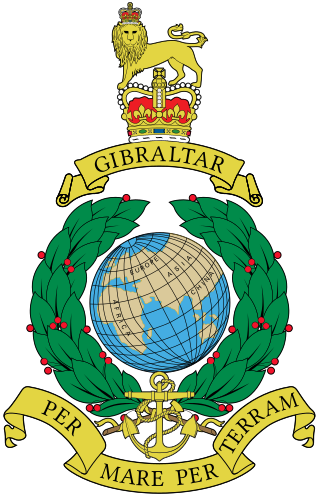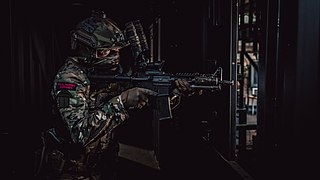
The Corps of Royal Marines (RM), also known as the Royal Marines Commandos, are the UK's special operations capable commando force, amphibious light infantry and also one of the five fighting arms of the Royal Navy. The Corps of Royal Marines can trace their origins back to the formation of the "Duke of York and Albany's maritime regiment of Foot" on 28 October 1664, and can trace their commando origins to the formation of the 3rd Special Service Brigade, now known as 3 Commando Brigade on 14 February 1942, during the Second World War.

The Commandos, also known as the British Commandos, were formed during the Second World War in June 1940, following a request from Winston Churchill, for special forces that could carry out raids against German-occupied Europe. Initially drawn from within the British Army from soldiers who volunteered for the Special Service Brigade, the Commandos' ranks would eventually be filled by members of all branches of the British Armed Forces and a number of foreign volunteers from German-occupied countries. By the end of the war 25,000 men had passed through the Commando course at Achnacarry. This total includes not only the British volunteers, but volunteers from Greece, France, Belgium, Netherlands, Canada, Norway, Poland, and the United States Army Rangers and US Marine Corps Raiders, which were modelled on the Commandos.

The Commandos Marine are the Special Operation Forces (SOF) of the French Navy. The Commandos Marine are nicknamed Bérets Verts. They operate under the Sailor Riflemen and Special Operations Forces Command (FORFUSCO) and form part of the French Special Operations Command.

Ski warfare is the use of ski-equipped troops in war.
45 Commando Royal Marines is a battalion sized unit of the British Royal Marines and subordinate unit within 3 Commando Brigade Royal Marines, the principal Commando formation, under the Operational Command of the Fleet Commander.

His Majesty's Naval Service is the United Kingdom's naval warfare and maritime service. It consists of the Royal Navy, Royal Marines, Royal Fleet Auxiliary, Royal Naval Reserve, Royal Marines Reserve and Naval Careers Service. The term Naval Service should be distinguished from the "UK Naval Services", which consist of the Naval Service and the Merchant Navy. The Naval Service as a whole falls under the command of the Navy Board, which is headed by the First Sea Lord. This position is currently held by Admiral Sir Ben Key. The Defence Council delegates administration of the Naval Service to the Admiralty Board, chaired by the Secretary of State for Defence.

The Royal Marines Reserve (RMR) is the volunteer reserve force used to augment the regular Royal Marines. The RMR consists of some 750 trained ranks distributed among the four units within the UK. About 10 percent of the force are working with the Regular Corps on long-term attachments in all of the Royal Marines regular units. All the volunteers within the RMR must pass through the same rigorous commando course as the regulars. The former may be civilians with no previous military experience or may be former regular Royal Marines.
The Brigade Patrol Troop is a reconnaissance troop of the United Kingdom's Royal Marines and is part of the Surveillance and Reconnaissance Squadron (SRS) within 30 Commando Information Exploitation Group.

The Mountain Warfare Training Center (MWTC) is a United States Marine Corps installation located in Pickel Meadows on California State Route 108 at 6,800 feet (2,100 m) above sea level in the Toiyabe National Forest, 21 miles (34 km) northwest of Bridgeport, California. The training center exists to train units in complex compartmented terrain.

The Portuguese Marine Corps constitutes the Elite Commando Raid Force and Special Operations branch of the Portuguese Navy. It has roles similar to the ones of the USMC Reconnaissance Battalions and of the Royal Marine Commandos. The Corps is specialised in amphibious warfare, coastal reconnaissance, unconventional warfare, guerrilla warfare, raids, maritime interdiction and boarding operations. It is an elite light infantry force, operating as a rapid-reaction force. Today’s Corpo de Fuzileiros is the premier raid force. The fuzileiros remains an all-volunteer force with an intensive screening and selection process followed by combat-focused training. Fuzileiros are resourced to maintain exceptional proficiency, experience and readiness.
The Skirmish at Top Malo House took place on 31 May 1982 during the Falklands War between Argentine special forces from 602 Commando Company and the British Royal Marines of the Mountain and Arctic Warfare Cadre. Top Malo House was the only planned daylight action of the war, although it was intended to take place in darkness. The Argentine commandos were part of an attempt to establish a screen of observation posts. A section that occupied Top Malo House was sighted by a British observation post of the Mountain and Arctic Warfare Cadre that was screening the British breakout from the lodgement around San Carlos. The action at Top Malo House was one of a series of mishaps and misfortunes that afflicted the Argentine effort.
A mountain leader is a military professional specialising in delivering training for, or leading, operations in high altitude and / or extremely low temperature environments.
30 Commando Information Exploitation Group RM is a battalion-sized unit of the Royal Marines and forms part of 3 Commando Brigade. The unit resources include communications, information operations, information systems, intelligence, surveillance, and Target Acquisition and Reconnaissance (ISTAR).

No. 10 (Inter-Allied) Commando was a commando unit of the British Army during the Second World War, recruited largely from non-British personnel from German-occupied Europe. This unit was used to help co-ordinate attacks with other allied forces.
Royal Marines recruit training is the longest basic modern infantry training programme of any Commonwealth, or North Atlantic Treaty Organization (NATO) combat troops. The Royal Marines are the only part of the British Armed Forces where officers and other ranks are trained at the same location, the Commando Training Centre Royal Marines (CTCRM) at Lympstone, Devon. Much of the basic training is carried out on the rugged terrain of Dartmoor and Woodbury Common with a significant proportion taking place at night.
In 1989 the Royal Navy was under the direction of the Navy Department in the UK Ministry of Defence. It had two main commands, CINCFLEET and Naval Home Command.

The Netherlands Maritime Special Operations Forces is the special forces unit of the Marine Corps of the Royal Netherlands Navy. It is one of the three principal units tasked with special operations in the Netherlands. The unit can be deployed worldwide to conduct special operations, including counter-terrorism both overseas and domestically, with a maritime focus. Its operations are planned and coordinated by the Netherlands Special Operations Command, as are the operations of the KCT.

The Future Commando Force (FCF) is an in-progress modernisation programme and model of the future role and operations of the Royal Marines. The FCF essentially retasks 40 Commando and 45 Commando with implementing the infantry component of two Littoral Response Groups (LRGs), though other units from 3 Commando Brigade are also included in the composition of LRGs, as well as changing the role and operations of the Royal Marines and the equipment and tactics they use. The FCF concept was created before 2019, when the first exercises and experiments with the FCF began. It was reinforced in the Defence in a Competitive Age command paper, which followed the Integrated Review. It describes the Royal Marines as a forward-deployed maritime special operations/special operations capable force which will work with greater agility and autonomy, and in smaller teams that specialise in raids within littoral zones, and operations within grey zones and other special operations to relieve and complement United Kingdom Special Forces (UKSF). The emphasis on the littoral role of the Royal Marines strongly links the FCF to the Littoral Strike concept, which is being developed and implemented by the LRGs. The FCF is also strongly linked to the "Autonomous Advanced Force" concept by its emphasis on leveraging new technologies to augment commandos on operations. A series of exercises from 2019–present have been key to developing the FCF, chiefly with experimentation.










